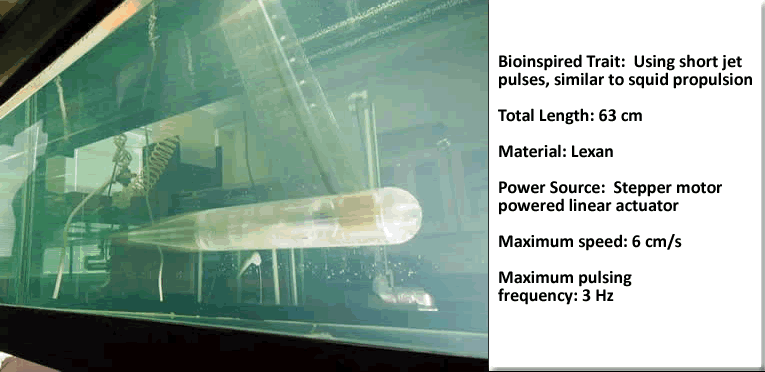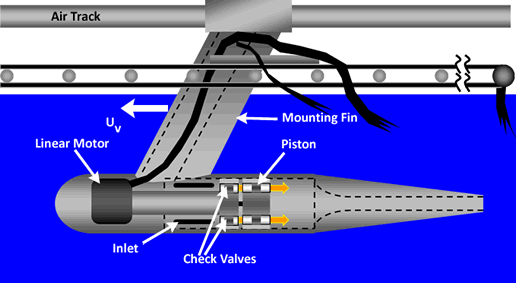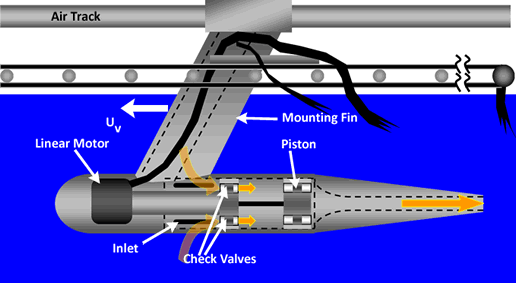
Robosquid

Background
Mechanical methods of jet propulsion like turbojets, pumpjets, and propellers use a steady flow of fluid through the propulsion system, but biological jetters use jet pulses. Short jet pulses generate a "puff" called a vortex ring or smoke ring, as illustrated in the video of a swimming Nemopsis bachei jellyfish shown in the biological propuslion section. To generate the puff, not only is the jet fluid accelerated, but surrounding fluid also has to be pushed out of the way. The acceleration of this additional fluid leads to an extra kick of thrust. Thus, pulsed jets are able to generate higher thrust per unit of ejected fluid, which can lead to improved cruise speed or escape capabilities. In addition, if short jet pulses are used, the additional thrust can be achieved without excessively elevating the kinetic energy expelled in the jet so that propulsive efficiency is improved, as has been observed in some swimming squid. In particular, pulsed jets may be more efficient than conventional jet propulsion (turbojets and propellers) have poor propulsive efficiency at small scales where the Reynolds number is small.
Robosquid was developed to study the propulsive efficiency of pulsed jets as size is reduced to see if and under what conditions pulsed jets can be more efficient than steady jets. The ultimate goal is to develop an efficient propulsion system for small scale devices that can be used in a variety of applications such as surveillance, intravenous drug delivery, or microsurgery.
How it works
Robosquid is comprised of a cylinder, a piston, and a linear motor to drive the piston, as shown in the schematics below. A pulsed jet is generated by oscillating the piston back and forth. During the power stroke, the piston is accelerated toward the rear of Robosquid, pushing fluid out of the nozzle and drawing fluid into Robosquid through four intake slots in the hull. During the recovery or refill stroke, the piston is pulled back to its original position. This action closes check valves between the intake slots and the piston(preventing fluid from exiting the intake slots) and opens check valves in the piston itself so that fluid behind the piston is transferred to the front of the piston without drawing fluid in through the nozzle.
 |
| Refill Stroke |
 |
| Power Stroke |
As Robosquid propels itself, it is guided in a straight line by an air track, which is basically like a long air hockey table. The air track provides very little resistance to the motion of Robosquid so it behaves like it were freely swimming in the tank.
A computer is used to precisely control the motor that drives the piston. This allows direct control over the amount of fluid ejected with each pulse, the variation of jet velocity with time, and the pulsing frequency.
While Robosquid uses a non-traditional propulsion system, it does not precisely mimic squid propulsion. Most notably, Robosquid has a rigid hull, and it ejects and intakes fluid at the same time. Real squid, on the other hand, eject and ingest fluid at alternating times during the propulsion cycle and their body expands and contracts during propulsion.
Observations
Experiments with Robosquid are currently ongoing, but a few key results have already been observed:
1) The propulsive efficiency of Robosquid is highest for short pulses in agreement with observations from swimming squid.
2) Comparison of Robosquid's propulsive efficiency with the propulsive efficiency expected if a steady jet were used to propel it at the same speed shows that generally a traditional steady jet is more efficient, except for short jet pulses at high frequency, where Robosquid can obtain higher propulsive efficiencies than a steady jet.
More information about Robosquid can be found here.
